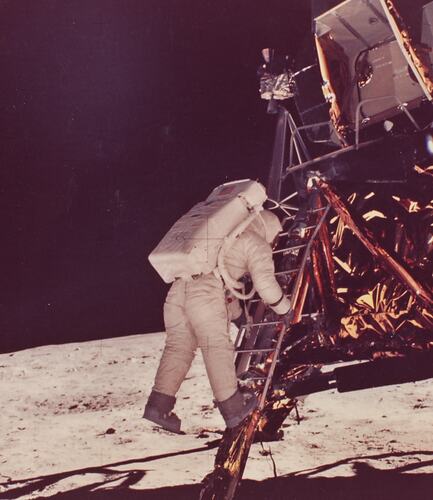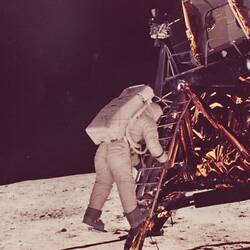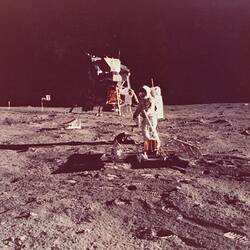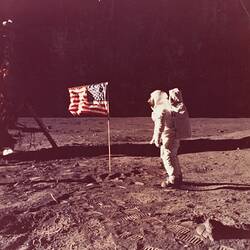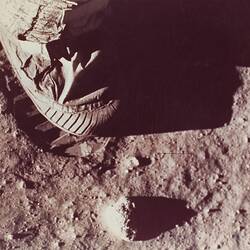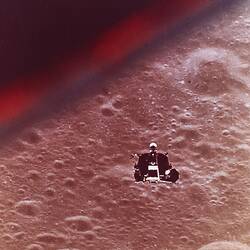Summary
Five colour photographs of the NASA Apollo 11 space mission to the Moon in July 1969.
The Apollo 11 spacecraft left earth from Cape Kennedy, Florida in the United States of America, on 16 July 1969. It landed on the moon a few days later on 20 July, where Commander Neil Armstrong and Lunar Module pilot Edwin 'Buzz' Aldrin walked on the surface of the moon, the first humans to do so. Command Module pilot Michael Collins maintained lunar orbit while his crewmates visited the moon surface. The crew landed back on earth on 24 July 1969.
The five images in this group feature Buzz Aldrin climbing down from the Lunar Module (the Eagle) to the moon surface; Buzz Aldrin standing in front of the American flag that had just been placed on the moon surface; Buzz Aldrin deploying the solar panels of a seismometer with the Eagle Lunar Module in the background (all taken by Neil Armstrong); astronaut boot on the moon (possibly Aldrin's); and the Eagle Lunar Module ascending from or descending to the moon.
Some of these images also appear in Coloramas promotional transparencies produced by Eastman Kodak Company.
These objects are part of the Kodak Heritage Collection of products, promotional materials, photographs and working life artefacts collected from Kodak Australasia in 2005, when the Melbourne manufacturing plant at Coburg closed down.
Kodak Australasia Pty Ltd manufactured and distributed a wide range of photographic products to Australasia, such as film, paper, chemicals, cameras and miscellaneous equipment. Its client base included amateur and professional photographers, as well as specialist medical and graphic art professionals who used photography, x-ray and other imaging techniques.
Physical Description
5 colour photographs.
More Information
-
Collection Names
-
Collecting Areas
-
Acquisition Information
Donation from Kodak (Australasia) Pty Ltd, Ms. Kate Metcalf - Kodak (Australasia) Pty Ltd, 2005
-
Acknowledgement
Courtesy of Kodak (Australasia) Pty Ltd.
-
Creator
Kennedy Space Centre, National Aeronautics & Space Administration (NASA), July 1969
NASA astronauts created these images on the Moon. -
Producer
Eastman Kodak Company, Rochester, New York, United States of America, July 1969
Eastman Kodak provided some photographic technical support for NASA astronauts to take these images, as well as doing some photographic printing and distribution of the images afterwards. -
Classification
Manufacturing & industry, Photographic products, Presentations
-
Category
-
Discipline
-
Type of item
-
References
[Link 1] accessed 4 March 2022
-
Keywords
Photography, Space, Space Flight, The Moon, Astronauts, Spacecraft, Spacesuits, DesignWeek2022
